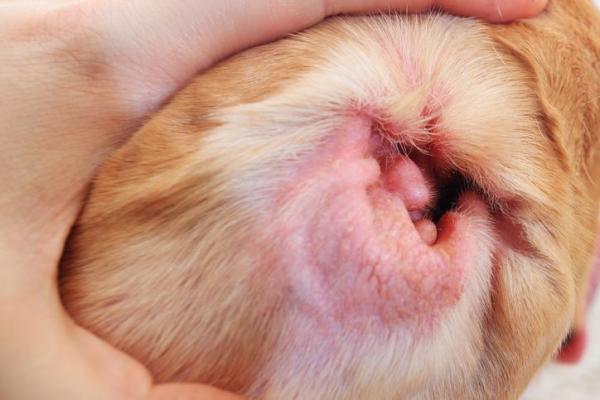External Otitis in Dogs - Symptoms And Treatment



See files for Dogs
External otitis in dogs is a relatively common canine disorder. External otitis in dogs is defined as an inflammation of the external auditory canal and may or may not affect the tympanic membrane and be accompanied by a dog ear infection. Common symptoms of otitis externa includes pain and itching. If your dog is suffering from external otitis, veterinarian consultation is necessary.
For more about the symptoms, diagnosis and treatment of otitis externa in dogs, keep reading here at AnimalWised.
External otitis in dogs: symptoms
Otitis externa in dogs symptoms my vary according to its severity. The most common include:
- Auricular erythema: redness of the inside of the ear due to an increase of blood in the area.
- Shaking of the head.
- Scratching of the ears.
- Pain in the area.
- Secretion, associated with dog ear infection.
- In cases of chronic otitis externa in dogs, hematomas and even deafness may occur.
External otitis in dogs: causes
The primary otitis externa in dogs causes include:
- Parasites.
- Hypersensitivity caused by pathologies, such as atopic dermatitis and adverse reactions to food: intolerance and allergy.
- Presence of foreign bodies and/or trauma.
- Neoplasms or polyps that obstruct the ear duct, although this is more common in cats.
- Keratinization related disorders that cause dry skin and are related to endocrine diseases such as hypothyroidism.
- Autoimmune diseases.
For more, we recommend reading our article where we discuss everything you need to know about external parasites on dogs.

Otitis externa in dogs: additional causes
Although these causes are not directly responsible for the appearance of otitis externa in dogs, these related conditions can aggravate and/or perpetuate the picture. Is your dog ear canal swollen shut? Additional and related causes of dog otitis externa include:
- Predisposing causes: although these are not enough to trigger external otitis, they can facilitate its appearance. Among these causes we include pendulous ear shapes which are more common in some dog breeds, such as Cocker Spaniels. This such ear shape hinders ear canal ventilation, creating a space for increased humidity. Additionally, ear canals which are covered with hair or are naturally narrower, are more prone to the development of otitis externa.
- Secondary causes: are those that tend to aggravate otitis externa over time. In this case, both the primary and secondary cause need to be treated. These include infections caused by bacteria or fungi, such as malassezia in dogs.
- Perpetuating factors: that physically prevent medical treatment such as hyperplasia, calcifications or stenosis. In this case, treatment would require surgery. If this otitis externa is not treated, it could result in the appearance of otitis media in dogs.
Otitis media in dogs
Otitis media refers to an infection of the middle ear. Otitis media often appears when otitis externa is not treated and spreads to the middle ear structure.
External otitis in dogs: diagnosis
Otitis externa in dogs diagnosis requires veterinary consultation. A vet will assess the state of the dog’s tympanic membrane by otoscopic examination. In the case of suppurative otitis externa in dogs, the eardrum will not be visible. Therefore, treatment will require flushing or an X-ray which allows for visibility of foreign bodies and/or tumors. Skin scrapings and smear tests may also be taken to test for parasites and autoimmune diseases. If your dog’s ear is painful at the touch, a veterinarian may opt for local anesthesia.
External otitis in dogs: treatment
Treatment for otitis externa in dogs will depend on the veterinarian diagnosis and it’s main cause. Otitis externa dogs medication favors topical treatment, which carries a lower risk of side effect. This topical medication is usually made up of antibacterial, anti-yeast and corticosteroids ingredients. Treatment is generally aimed at controlling ear duct inflammation and infection (when present).
If, however, there are visible lesions in the ear canal, topical treatment is not recommended. A veterinarian may also opt for gentle cleaning, especially in the case of wax build-up. Additionally, it’s important that the primary cause is treated to avoid recurrence.
Follow up veterinary check-ups will be necessary to control the causes and monitor treatment.
For more, we recommend reading our article where we list the best home remedies for dog ear infection.

This article is purely informative. AnimalWised does not have the authority to prescribe any veterinary treatment or create a diagnosis. We invite you to take your pet to the veterinarian if they are suffering from any condition or pain.
If you want to read similar articles to External Otitis in Dogs - Symptoms And Treatment, we recommend you visit our Other health problems category.







